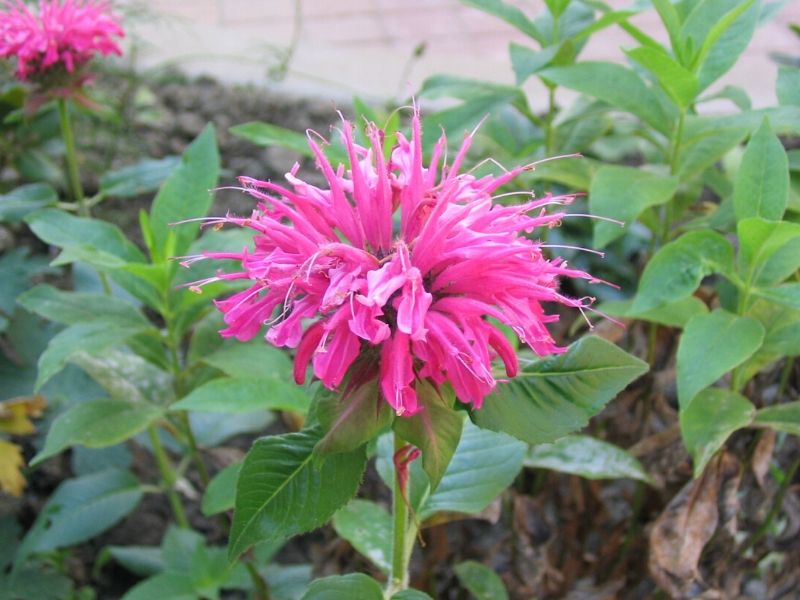Milkweed (Asclepias) is a plant with many names, such as butterfly flower, silkweed, butterfly weed, and swallow-wort. This herbaceous perennial is a perfect addition to a butterfly garden because the butterfly species, like the monarch, enjoy feeding on the sweet nectar these flowers produce. Milkweed can also be attractive with clusters of flowers in vibrant colors like white, yellow, green, purple, pink, orange, and red.
For a healthy butterfly garden, combining milkweed with companion plants like garden phlox, sunflowers, catmint, wild bergamot, or blanket flowers is best. This combination of florals will help nourish monarch butterflies and other beneficial insects.
In this guide, we will explore these different milkweed companions and discuss creative ways to use them in your garden to create striking spaces.
What to Grow with Milkweed
If you want to grow a garden that produces an abundance of attractive flowers yet is easy to maintain, it is best to combine plant species with similar growing requirements in your garden beds or containers.
Butterfly weed is a plant that requires lots of space to expand and grow, and it should be established in full sun for optimal flowering. Gardeners should know that the growing conditions can vary slightly for different milkweed species. For example, swamp milkweed (Asclepias incarnate) prefers moist soil, while tropical milkweed (Asclepias curassavica) is more drought tolerant but needs regular watering. On the other hand, common milkweed or butterfly flower (Asclepias syriaca) is hardy and only needs to be watered during spells of drought.
Because of these differences in growing conditions, gardeners must be careful when pairing different plant species with varying milkweed species.
Look at exciting plant species that should grow well in full sun alongside your milkweed flowers.
Garden Phlox

Phlox flowers (Phlox) are great companion plants if you want a ground cover to grow in front of your milkweed shrubs. This beautiful plant has many different varieties, including pink, rose, red, lavender, orange, and white flowers. These vivid flowers will attract lots of butterflies and bees and are great for adding more color and contrast to your garden.
These self-spreading evergreen perennials will thrive if you plant them in full sun in well-drained soil. They are quite hardy and must only be watered once a week during dry spells. You can combine them with whorled milkweed (Asclepias verticillata) or butterfly weed (Asclepias tuberosa).
Phlox will only grow two to three feet tall, so it is best to position them in front of your gardens.
Sunflowers

Sunflowers (Helianthus) are ideal for pollinator gardens because they attract many beneficial insects with their large showy flowers. For milkweed, it is best to choose ornamental or perennial sunflower species like beach sunflowers (helianthus debilis) because these are easier to maintain and tend to be a better food source for monarch butterflies.
These milkweed companion plants should be positioned in a sunny spot where they receive at least six hours of direct sun daily. They prefer loose soil that drains well and can be watered infrequently.
When doing companion planting with milkweed, it is usually best to establish the shorter variety in the front with taller species behind it so all the flowers in your garden will receive adequate sun.
Catmint

Catmint (Nepeta cataria), also known as catnip or catswort, is one of the best companion plants to include in your garden because its strong fragrance will attract lots of monarch butterflies. The vivid purple flowers of this plant will complement purple milkweed or can create lots of contrast alongside butterfly weed with its orange flowers.
Catmint is very easy to grow. It will take well to any well-drained soil, and it can grow in dappled shade but flowers best in full sun. This herb can survive spells of drought but prefers regular weekly watering.
You can grow this shrub species alongside shorter milkweed species to create showy mixed borders or grow it in front of taller milkweed shrubs for a fuller garden appearance.
Wild Bergamot

Wild bergamot (Monarda fistulosa), also known as bee balm or horsemint, will add interest and texture to your garden because it produces frisky flowers in colors like lavender, pink, white, or red.
These plants require a full sun position with free-draining soil, and they should be watered sparingly, or they can develop root rot.
The bushy plants can grow rather tall, with a maximum height of up to 4 feet tall. For this companion plant, it is best to select milkweed varieties with a similar height to create a lush garden full of color.
Blanket Flowers

Blanket flowers (Gaillardia) are easy to grow and will brighten up your garden with vivid orange and yellow flowers. They will also add lots of texture to your garden beds because their foliage is quite delicate.
These hardy flowers will thrive if you place them in full sun and can take well to any free-draining soil. The flowers are drought and heat-tolerant and should be paired with milkweed varieties that are also water-efficient.
The flowers don’t grow too tall and usually only reach 1 – 3 feet. Because of their short stature, using them as a border plant in front of your milkweed shrubs is usually best.
What NOT to Grow with Milkweed
Milkweed species have different growing requirements but most of them need a minimum of 6 hours of direct sunlight in order to produce vivid flowers. Because they rely so much on direct sunlight, it is best not to grow them with shade-loving plant species like ferns, hostas, or begonias because these delicate species will only wilt in hot and sunny gardens.
Landscaping Ideas for Milkweed and Companions
Now that you know what plant species to include in your garden, it is time to discuss different ways to combine them in your landscape. Here is a quick look at some creative concepts for these charming butterfly food sources.
Butterfly Gardens
Naturally, you can plant lots of milkweeds if you want to support butterfly species. These plants offer lots of nutrients and are great for increasing the butterfly population. For an effective butterfly garden, it is best to combine all sorts of flowering species like bee balm, blanket flower, catmint, phlox, and sunflowers in mixed garden beds. This will create a striking effect and is sure to lure lots of animal life to your garden thanks to the wider range of floral fragrances.
Container Gardens
Milkweed is a good container garden plant and can be paired with other plant species to create a charming container garden. You can mix milkweed and other plants with a similar height in window boxes to enhance the aesthetics of your home. Alternatively, you can grow milkweed in the center of a large container with a ground cover like phlox all around it to create a showy display of color.
Final Thoughts
Milkweed is a wonderful plant to include in ornamental gardens and it can be paired with all sorts of companions like sunflowers, bee balm, catmint, phlox, and blanket flowers to create showy pollinator gardens.
We hope that our guide made it easier to find suitable neighbors for your milkweed flowers and that you found lots of inspiration for a showy garden of your own.
See more:







